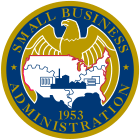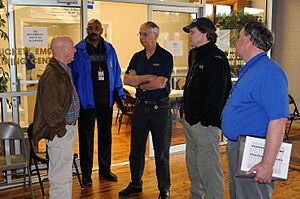Small Business Administration facts for kids

Seal of the SBA
|
|
Logo of the SBA
|
|
| Agency overview | |
|---|---|
| Formed | July 30, 1953 |
| Preceding agency |
|
| Jurisdiction | Federal government of the United States |
| Headquarters | 409 Third St SW Washington, D.C., U.S. |
| Employees | 3,293 (2015) |
| Annual budget | $710 million USD (2015) |
| Agency executives |
|
The United States Small Business Administration (SBA) is a special agency of the U.S. government. It helps people who want to start or grow their own small businesses. The SBA's main job is to make the nation's economy strong. It does this by helping small businesses get started and stay successful. The agency also helps communities get back on their feet after disasters.
The SBA's work can be thought of as "3 Cs":
- Capital: Helping businesses get money (loans).
- Contracts: Helping small businesses get government jobs.
- Counseling: Giving advice and training to business owners.
The SBA works with banks and other lenders to offer loans. The SBA guarantees part of these loans. This makes it easier for small businesses to get the money they need. This support was increased after 2008 to help businesses during tough economic times.
The SBA also helps small businesses get a fair share of government contracts. It makes sure that a certain percentage of federal contracts go to small businesses. This includes businesses owned by women or veterans with disabilities. The SBA also has special programs like the 8(a) Business Development Program.
The SBA has offices in every U.S. state. It also supports many partners who offer advice. These partners include Small Business Development Centers, Women's Business Centers, and SCORE. These groups help over a million entrepreneurs every year.
Contents
History of the SBA
The SBA was created on July 30, 1953. President Eisenhower signed the Small Business Act to start it. The main goal of the SBA was, and still is, to "aid, counsel, assist and protect" small businesses.
The SBA has faced challenges over the years. In 1996, some lawmakers wanted to close the agency. But it survived and even received more money in 2000. Later, there were efforts to cut its budget. However, the SBA continued to receive support. In 2009 and 2010, its budget was strengthened. In 2011, President Obama announced that the SBA would double its support for small businesses in rural areas.
How the SBA is Organized
The SBA has a leader called the Administrator and a Deputy Administrator. It also has many different offices. Each office focuses on a specific area to help small businesses.
Some of these offices include:
- Business Development
- Capital Access (helping with money)
- Disaster Assistance
- Entrepreneurial Development (helping new businesses)
- Government Contracting
- International Trade
- Veterans Business Development
- Women's Business Ownership
SBA Lending Programs
The SBA offers different types of loans to help small businesses. These loans are usually given through banks that partner with the SBA.
Loan Guarantee Program
The 7(a) Loan Guarantee Program is the most common SBA loan. It helps people start or expand their small businesses. The SBA guarantees part of the loan. This makes banks more willing to lend money to small businesses. These loans can be used for things like daily expenses, paying off other debts, or buying equipment. The SBA's guarantee helps businesses that might not get a traditional loan.
Disaster Loan Program

After a declared disaster, the SBA offers special loans. Homeowners and renters can get low-interest loans to fix their damaged homes. Businesses can also get these loans to recover from the disaster. These loans help communities rebuild quickly.
Microloan Program
The Microloan program provides smaller loans, up to $50,000. These loans go to small businesses and child-care centers. The program also offers advice and training to help these businesses succeed.
Programs for Entrepreneurs
The SBA has many programs to help people learn how to run a business.
Small Business Development Centers
There are about 900 Small Business Development Centers (SBDCs) across the country. They are often located at colleges or universities. SBDCs offer free or low-cost advice and training to small business owners.
The Office of Women's Business Ownership
This office helps women entrepreneurs. It provides training, counseling, and helps women get loans. It also works to make sure women-owned businesses get a fair chance at government contracts.
Women's Business Centers
Women's Business Centers (WBCs) are non-profit centers across the U.S. They help women start and grow small businesses. WBCs offer training, mentoring, and help with getting money. They serve over 100,000 women entrepreneurs each year. Many WBC clients are low-income or people of color. They offer services in many different languages.
SCORE Mentoring Program
SCORE is a group of volunteer business mentors. It was started in 1964 to help small business owners. SCORE has over 10,000 volunteers who are experienced business leaders. They offer free advice and workshops. In 2016, SCORE helped clients create over 54,000 new businesses.
SCORE mentors help with things like writing business plans, developing products, and marketing. You can meet with a mentor in person, or get help through email or video calls. SCORE also offers many educational workshops online and in person.
Veteran Business Outreach Centers (VBOC)
The SBA has centers that help businesses owned by veterans and their families. These centers provide training and advice. They also teach a program called "Boots to Business" to help veterans start their own companies.
Federal Contracting Programs
The SBA helps small businesses get contracts from the U.S. government.
8(a) Business Development Program
The 8(a) Business Development Program helps small businesses owned by people who have faced social or economic challenges. This program helps these businesses grow for a period of nine years. It helps them get government contracts. This program has created many jobs and helped communities. About 5% of government small business contracts go to 8(a) firms each year.
Office of Hearings and Appeals
The Office of Hearings and Appeals (OHA) is a special office within the SBA. It was created in 1983. The OHA acts like a court for certain SBA decisions. It hears appeals if a business disagrees with a decision made by the SBA.
The OHA can hear appeals about:
- The size of a business.
- Eligibility for programs like those for veteran-owned or women-owned businesses.
- Decisions about the 8(a) program.
The OHA shares its decisions publicly.
See also
 In Spanish: Agencia Federal de Pequeños Negocios de Estados Unidos para niños
In Spanish: Agencia Federal de Pequeños Negocios de Estados Unidos para niños

